News about the Los Angeles Fire Department’s (LAFD) use of drones to fight the Skirball fire was covered far and wide, with details about how the technology was used to increase firefighter safety and operational effectiveness. The drones were airborne for approximately 30 minutes doing aerial damage assessments and checking for hotspots in an area at the north end of Moraga Drive.
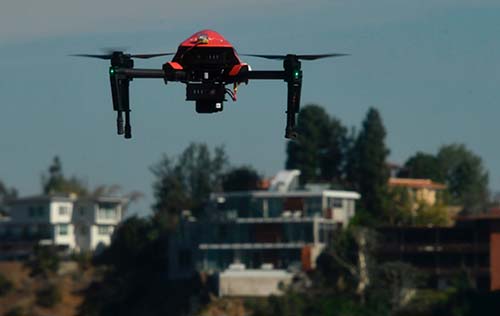 Since then, the department’s use of the technology has expanded, but it’s important to recognize the humble beginnings of LAFD’s program. All of it came from brainstorming sessions around the potential applications of the technology, and research into where it could make a difference. If the LAFD could use a drone for damage assessment, why couldn't they use it for a whole lot of other things?What the LAFD did at the Skirball fire was the culmination of almost two years worth of homework and research and careful documentation. They knew that putting a drone in the sky was going to be beneficial, but they also knew they had to answer questions about why it was valuable, how they were going to do it, and make sure the public was aware of both what they would and wouldn’t be doing with the drone. Their approach has created a blueprint for the successful creation of a drone program in the public safety sector.What Does it Mean to Use a Drone in an Emergency Situation? In order to understand how the LAFD has been able to effectively use drones in emergency situations, we need to understand what takes place when they're actually using this technology, and how they’ve traditionally approached certain firefighting tasks. For the LAFD, their adoption of drones was all about providing their IC’s (Incident Commander) with better situational awareness so they could more effectively deploy their resources and keep people safe.With fires and in emergencies, firefighters are heavily reliant on radio communication. Firefighters are taught to communicate over the radio in a way that paints a picture for the IC so that they can make a decision based on what’s happening. That can include anything from ventilating a roof to evacuating a specific area in a brush. As effective as that communication has proven to be, the old expression of “a picture is worth 1,000 words” comes to play, and the real-time pictures provided from drones have proven to make all the difference in the world.
Since then, the department’s use of the technology has expanded, but it’s important to recognize the humble beginnings of LAFD’s program. All of it came from brainstorming sessions around the potential applications of the technology, and research into where it could make a difference. If the LAFD could use a drone for damage assessment, why couldn't they use it for a whole lot of other things?What the LAFD did at the Skirball fire was the culmination of almost two years worth of homework and research and careful documentation. They knew that putting a drone in the sky was going to be beneficial, but they also knew they had to answer questions about why it was valuable, how they were going to do it, and make sure the public was aware of both what they would and wouldn’t be doing with the drone. Their approach has created a blueprint for the successful creation of a drone program in the public safety sector.What Does it Mean to Use a Drone in an Emergency Situation? In order to understand how the LAFD has been able to effectively use drones in emergency situations, we need to understand what takes place when they're actually using this technology, and how they’ve traditionally approached certain firefighting tasks. For the LAFD, their adoption of drones was all about providing their IC’s (Incident Commander) with better situational awareness so they could more effectively deploy their resources and keep people safe.With fires and in emergencies, firefighters are heavily reliant on radio communication. Firefighters are taught to communicate over the radio in a way that paints a picture for the IC so that they can make a decision based on what’s happening. That can include anything from ventilating a roof to evacuating a specific area in a brush. As effective as that communication has proven to be, the old expression of “a picture is worth 1,000 words” comes to play, and the real-time pictures provided from drones have proven to make all the difference in the world.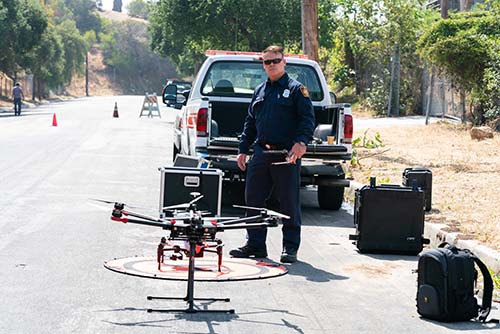
LAFD Firefighter Derrick Ward
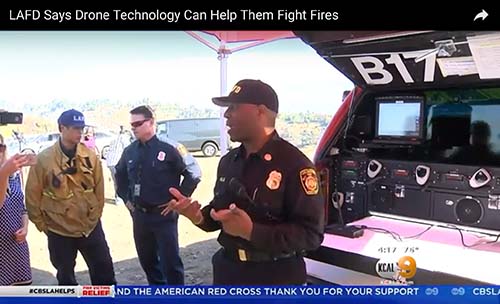 “When we first started talking about creating a program, out city attorney had a lot of concerns,” Chief Fields told Commercial UAV News. “It’s why we made an active effort to proactively reach out to the public, to the city and even to the ACLU about what we were doing. We asked the ACLU to review our documentation to tell us if there were any gaps, and because we reached out to them first, we were able to include their concerns in our documentation about our policy and process in records retention and how the chain of custody for any footage of data that we collected using the drone. I think the success of our program culminating with our first official flight at the Skirball fire was really about us not rushing through the process.”Communication and transparency with everyone is a concept that extended across the department itself, since it included outreach to LAFD air operations. The Chief Pilot and Swarm Battalion Chief knew from the very beginning what the program was intended to do, and what it wasn’t intended to do. It was made clear to them that the drone program can never and will never be a replacement for LAFD air assets. While manned aircraft are doing the mission-critical tasks, such as moving injured patients or doing critical water drops at active brush fires, drones can be used to do some of the less critical, but still important work simultaneously. That's damage assessment, mapping, or just providing overwatch for an IC.It’s why the advice LAFD officials have for anyone looking to enable similar success comes down to being completely transparent to everyone. Whether it's the board of fire commissioners, city council, or even with people working elsewhere within the department. Doing this will get the support that is needed, and can be the difference between a program that is successful and one that gets eliminated.“I believe in and am committed to this technology, but I've seen programs get shut down,” FF Ward continued. “The number one reason that happens is because of privacy concerns and things being done that people aren't aware of. They're afraid, and so political pressure, whether it's from a city council or wherever else, is put on. Programs will get shut down because it's the expedient thing to do. It'll sink you if you don't take care of it. It’s why we were completely transparent in developing the LAFD program.”For any department that wants to enable similar success, it's important to be proactive, to obtain community approval, and to demonstrate the proof of concept when it comes to saving lives and property. Of course, doing so is just part of the initial and ongoing considerations around what it means to legally and safely leverage this technology in the present and future.
“When we first started talking about creating a program, out city attorney had a lot of concerns,” Chief Fields told Commercial UAV News. “It’s why we made an active effort to proactively reach out to the public, to the city and even to the ACLU about what we were doing. We asked the ACLU to review our documentation to tell us if there were any gaps, and because we reached out to them first, we were able to include their concerns in our documentation about our policy and process in records retention and how the chain of custody for any footage of data that we collected using the drone. I think the success of our program culminating with our first official flight at the Skirball fire was really about us not rushing through the process.”Communication and transparency with everyone is a concept that extended across the department itself, since it included outreach to LAFD air operations. The Chief Pilot and Swarm Battalion Chief knew from the very beginning what the program was intended to do, and what it wasn’t intended to do. It was made clear to them that the drone program can never and will never be a replacement for LAFD air assets. While manned aircraft are doing the mission-critical tasks, such as moving injured patients or doing critical water drops at active brush fires, drones can be used to do some of the less critical, but still important work simultaneously. That's damage assessment, mapping, or just providing overwatch for an IC.It’s why the advice LAFD officials have for anyone looking to enable similar success comes down to being completely transparent to everyone. Whether it's the board of fire commissioners, city council, or even with people working elsewhere within the department. Doing this will get the support that is needed, and can be the difference between a program that is successful and one that gets eliminated.“I believe in and am committed to this technology, but I've seen programs get shut down,” FF Ward continued. “The number one reason that happens is because of privacy concerns and things being done that people aren't aware of. They're afraid, and so political pressure, whether it's from a city council or wherever else, is put on. Programs will get shut down because it's the expedient thing to do. It'll sink you if you don't take care of it. It’s why we were completely transparent in developing the LAFD program.”For any department that wants to enable similar success, it's important to be proactive, to obtain community approval, and to demonstrate the proof of concept when it comes to saving lives and property. Of course, doing so is just part of the initial and ongoing considerations around what it means to legally and safely leverage this technology in the present and future. 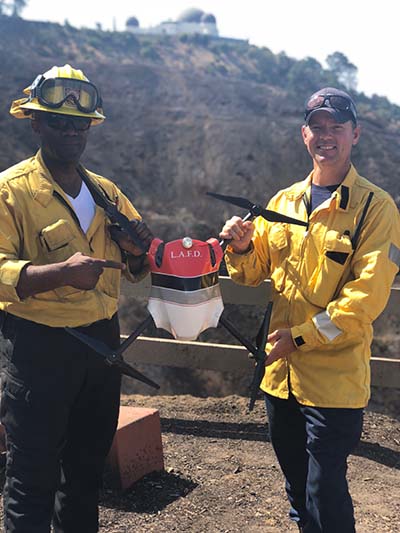 Drone Program Details – Part 107, COAs, Training and MoreSuccess with a drone program isn’t just about permission, it’s also about policy and process. The LAFD treats a UAV as an aircraft, and that if someone is operating a drone, the same kind of processes and procedures related to mission-planning that a pilot for manned aircraft goes through are what an unmanned pilot should go through. What does it take for their pilots to be proficient when they launch a drone in the air? That's one of the questions their program was built around, and these are all details that ensure the safe and legal operation a drone.It’s part of the reason that a prerequisite to fly a drone for the LAFD is a minimum of 20 hours of documented flight time and a Part 107 Certificate. In researching these requirements, officials realized that the safest way to protect the department, to protect the pilot and to maximize the use of the drone, LAFD drone pilots needed to work under the LAFD COA at certain times, but there are also things that don't fall under that COA.“I'll give you a perfect example,” Chief Fields explained. “We provided overwatch at the LA Marathon. But until something actually happens, it's not deemed an emergency so it wouldn't fall under our COA. However, we could do overwatch and do some pre-assessment planning with the drone under our Part 107. That’s why all of our pilots at a minimum must have their Part 107.”These differences and distinctions are just part of the reason the LAFD has been able to have the success they’ve had. It’s about a commitment to the technology that goes beyond aerials and awareness and involves process and training. It’s also something the LAFD is helping to define in more ways than one.For the first time in its history, drones were featured at the 2018 Fire Department Instructors Conference and Expo (FDIC). Representing the LAFD, Chief Fields from B10, FF Ward from FS80 and FFPM Dave Danielson from the TEMS Unit were invited to provide expertise and instruction during the H.O.T. (Hands On Training) evolutions for "Unmanned Aircraft Systems Use in Emergency Response”. Participants experienced hands-on demonstrations in the areas of Live Fire (Structural and Wild-land), Hazmat, Search and Rescue, and photography/videography UAS operations. FF Ward and FF Danielson also helped present an introduction to thermal imaging configured on a drone.This training session is just the first of many that LAFD is looking to provide, with the next session coming up in January. Their commitment to helping Fire Chiefs from across the country gain knowledge on best practices to initiate their own programs is an extension of the commitment that emergency response officials have made to the public and to one another.“I've had buddies blown up when they opened a door and the room exploded,” FF Ward said. “Better situational awareness could have prevented that. If we just save one life, that's worth it, but we're not going to save one life with this, we're going to save hundreds. Not only firefighter lives, but civilians too. That's people lost, stranded, or in danger. That's where all of this is going. I hope it's an eye-opener to everyone in a department because they need to realize that this technology can be the difference between having someone sitting across from you at the dinner table and them just not being there anymore. Or you not being there anymore.”
Drone Program Details – Part 107, COAs, Training and MoreSuccess with a drone program isn’t just about permission, it’s also about policy and process. The LAFD treats a UAV as an aircraft, and that if someone is operating a drone, the same kind of processes and procedures related to mission-planning that a pilot for manned aircraft goes through are what an unmanned pilot should go through. What does it take for their pilots to be proficient when they launch a drone in the air? That's one of the questions their program was built around, and these are all details that ensure the safe and legal operation a drone.It’s part of the reason that a prerequisite to fly a drone for the LAFD is a minimum of 20 hours of documented flight time and a Part 107 Certificate. In researching these requirements, officials realized that the safest way to protect the department, to protect the pilot and to maximize the use of the drone, LAFD drone pilots needed to work under the LAFD COA at certain times, but there are also things that don't fall under that COA.“I'll give you a perfect example,” Chief Fields explained. “We provided overwatch at the LA Marathon. But until something actually happens, it's not deemed an emergency so it wouldn't fall under our COA. However, we could do overwatch and do some pre-assessment planning with the drone under our Part 107. That’s why all of our pilots at a minimum must have their Part 107.”These differences and distinctions are just part of the reason the LAFD has been able to have the success they’ve had. It’s about a commitment to the technology that goes beyond aerials and awareness and involves process and training. It’s also something the LAFD is helping to define in more ways than one.For the first time in its history, drones were featured at the 2018 Fire Department Instructors Conference and Expo (FDIC). Representing the LAFD, Chief Fields from B10, FF Ward from FS80 and FFPM Dave Danielson from the TEMS Unit were invited to provide expertise and instruction during the H.O.T. (Hands On Training) evolutions for "Unmanned Aircraft Systems Use in Emergency Response”. Participants experienced hands-on demonstrations in the areas of Live Fire (Structural and Wild-land), Hazmat, Search and Rescue, and photography/videography UAS operations. FF Ward and FF Danielson also helped present an introduction to thermal imaging configured on a drone.This training session is just the first of many that LAFD is looking to provide, with the next session coming up in January. Their commitment to helping Fire Chiefs from across the country gain knowledge on best practices to initiate their own programs is an extension of the commitment that emergency response officials have made to the public and to one another.“I've had buddies blown up when they opened a door and the room exploded,” FF Ward said. “Better situational awareness could have prevented that. If we just save one life, that's worth it, but we're not going to save one life with this, we're going to save hundreds. Not only firefighter lives, but civilians too. That's people lost, stranded, or in danger. That's where all of this is going. I hope it's an eye-opener to everyone in a department because they need to realize that this technology can be the difference between having someone sitting across from you at the dinner table and them just not being there anymore. Or you not being there anymore.”

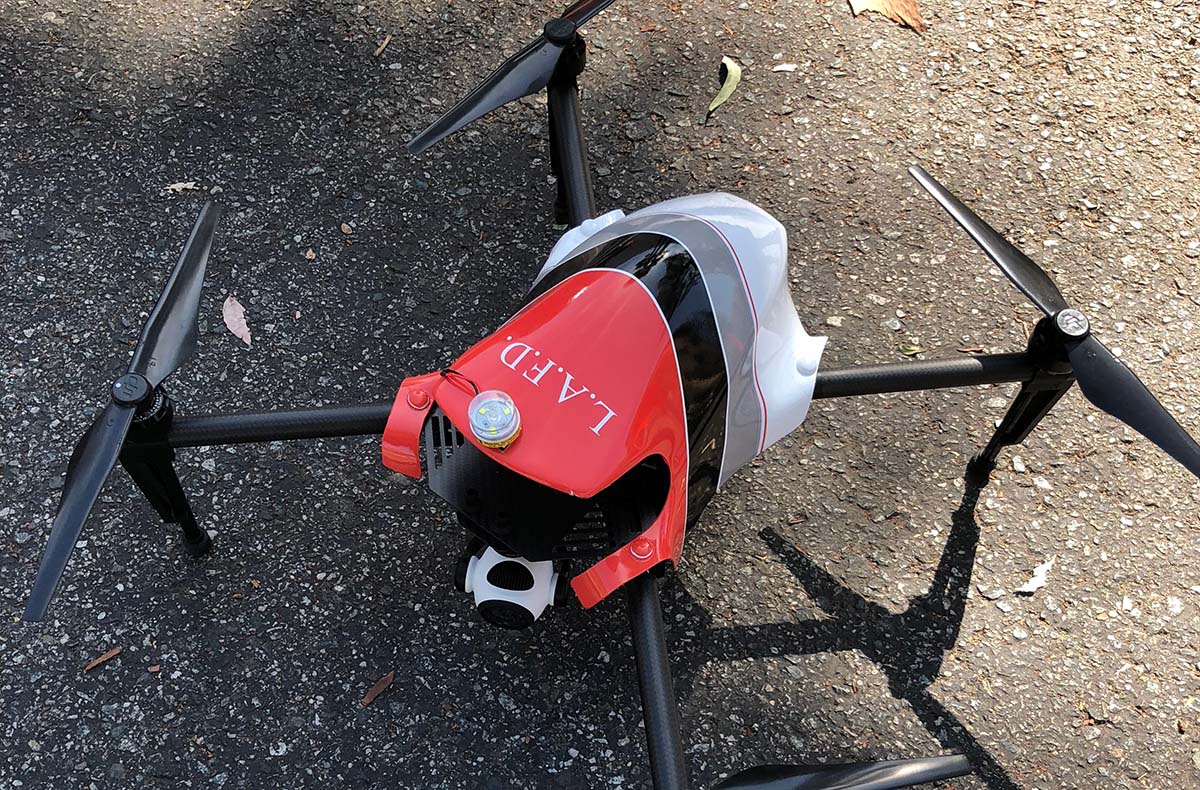












Comments